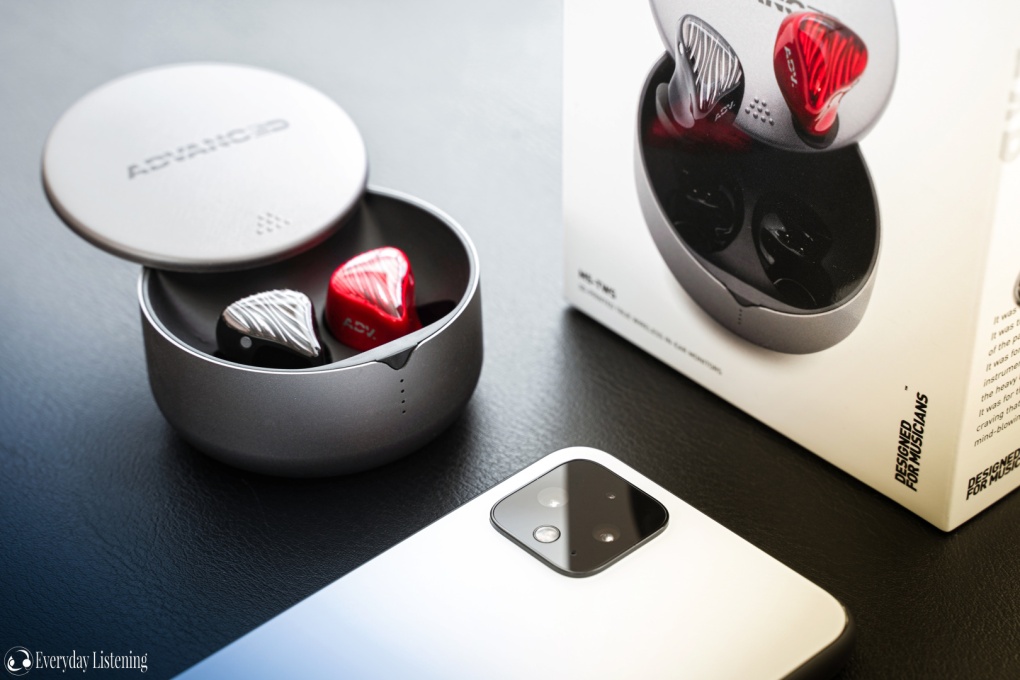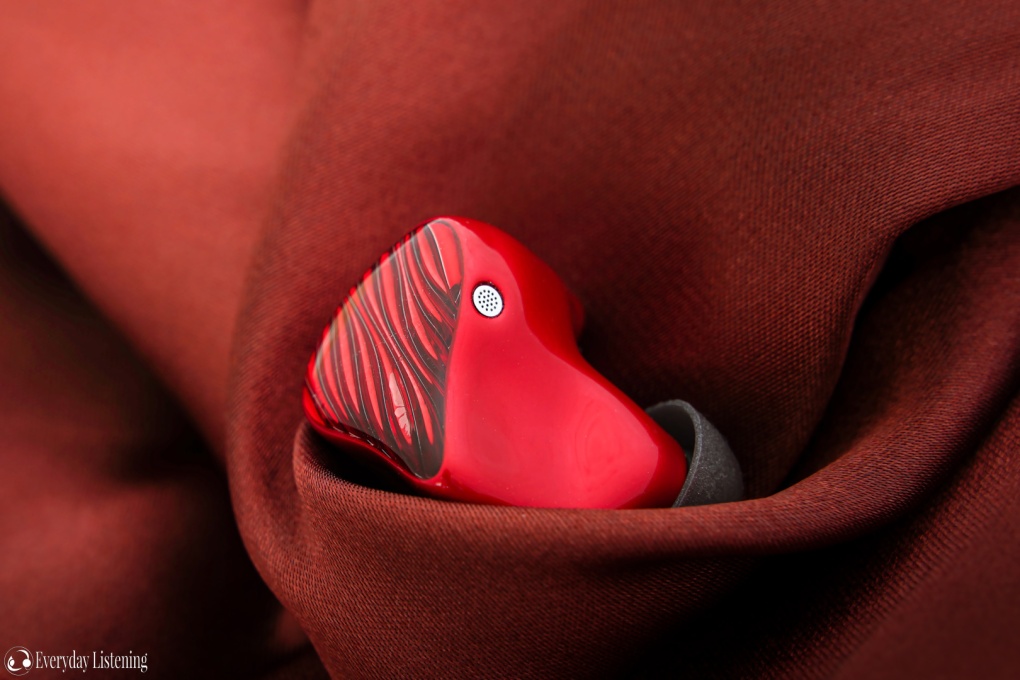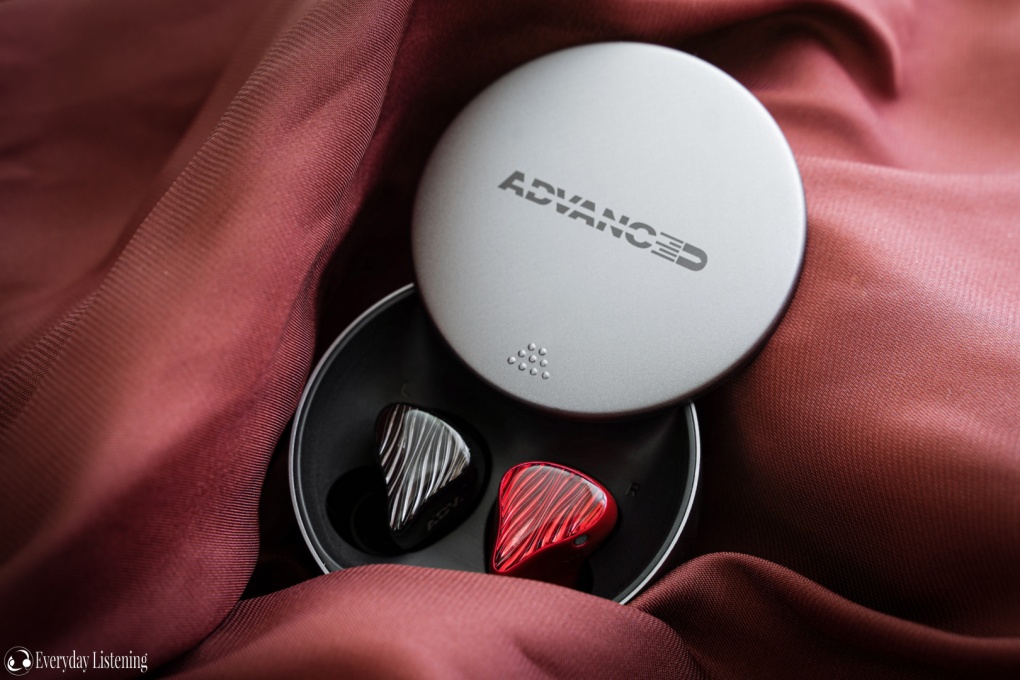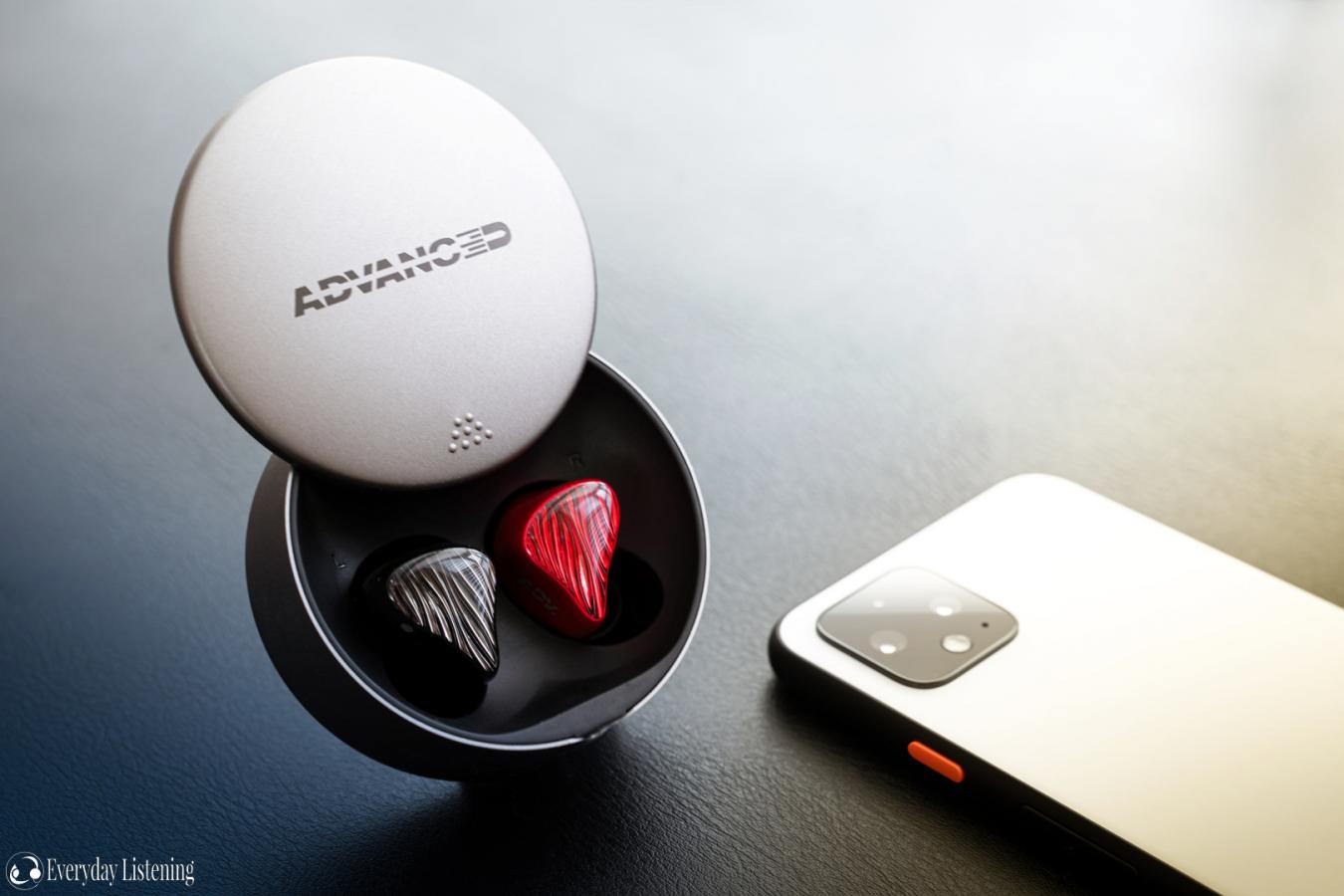Pros –
Revealing signature, Class-leading technical ability, Gorgeous design and case, Excellent battery life, Harman-target tuning
Cons –
No app integration, Forward upper-midrange, Unable to power the earphones on without the case
Verdict –
The M5 TWS joins the select elite of TWS earphones, offering class-leading resolution, a proper soundstage and very strong if not quite perfect balance.
Introduction –
Rising from humble crowd-funded beginnings to international notoriety in just a few years, ADV. has captured the market with their value-orientated products and unique designs that cater to audiophiles and average consumers alike. More so, the company has set out to merge these communities, implementing cutting-edge technology to bring high-end audio to the standard consumer and likewise, consumer convenience to audiophiles. The M5 TWS exemplifies this ethos, designed in-house from the ground up, it is somewhat of an outlier in the TWS space. Coming in at $199 USD, it sports a finely tuned sound designed to trace the Harman Curve alongside a unique housing design reminiscent of high-end wired monitors, the M5 TWS shows great promise. It supports the latest Bluetooth standard and Qualcomm’s high-res codecs to ensure that every link in the audio chain is strong. You can read more about the M5 TWS and treat yourself to one here.
Tech Specs –
Driver unit 6.1mm PHPC (Pressurized High-Purity Copper) dynamic driver
Impedance 16ohm+/-15%
Sensitivity 95dB+/-3dB at 1kHz
Frequency response 20Hz – 20kHz
Music time Up to 32 hours (w/ case) / up to 9 hours (earphones only)
Charging time 2 hours
BT version 5.0
Connection distance 10m (33ft)
Input port USB-C
Battery 360mAh (case) / 40mAh x 2 (earphones)
Unboxing –

The ADV. M5 TWS comes within a small, clean box that slides open to reveal the earphones nestled within the carrying case, all enclosed in protective foam. Just beneath are the accessories where ADV. offers 3 sizes of silicone tips in 2 styles, some shallower fitting tips similar to those included with Earfun’s Free and some more traditional tips similar to those provided with most in-ears. A pair of small memory foam tips are also included which provide a slightly more personalised fit as they conform to the ear. They aid isolation and enhance fit stability, making them my go-to. Of course, experiment with the tips to find which works best for your individual ear anatomy, for instance, despite getting a solid seal with both the medium and large silicone tips, the large tips were noticeably bassier indicating a better fit despite a similar in-ear feel. A USB-C charging cable is also provided to keep the case topped up.
3D Printed Housings –

While mostly used for custom earphones, ADV. leverage their foray into such form factors to create more ergonomic universals. Utilising 3D printing, which permits ADV. to finely contour their housings and referencing an extensive library of ear impressions, ADV. has created a housing that maximises comfort and fit for the vast majority. The finish is perfect, the clear coat is smooth and flawless with no bubbles or contamination. The M5 TWS carries the refinement of a consumer product and demonstrates that we’ve come far from the rough 3D printing of old.
PHPC Driver –
The M5 implements a pressurized high-purity carbon driver. We’ve seen this done before, the high tensile strength of carbon enables a thinner, lighter and quicker accelerating diaphragm while minimising modal distortion. A high mass voice coil that increases stroke alongside an enclosure that increases pressurisation should translate to strong bass extension while retaining strong treble extension. ADV. also puts emphasis on the housing design and acoustic filter system that has been used to create a sound that traces the Harman target curve. In my testing, this is not 100% accurate, however, the resulting sound is certainly very revealing and well-balanced.
High Res Codec –
By implementing Qualcomm’s QC3020 chipset, the M5 supports Qualcomm’s Apt-X codec in addition to AAC which both provides higher fidelity than standard SBC. HD is not supported, however, I am not aware of a TWS chipset that supports this feature at present. This is BT 5.0 chip that supports stereo plus (both earpieces paired in tandem in mono) in addition to independent pairing of each earpiece to either reduce latency or extend battery life. The chip has an in-built DSP and low power consumption that enables ADV. to hit their design goals more easily.
Design –
We’ve all likely heard of 3D printing before, yet it’s astonishing how quickly the technology has developed to now enable mass production of finely finished products. The M5 TWS is a delight to the eye with rippled faceplates underlying an immaculate high-gloss finish. The contours are smooth and refined, the design perfectly realised on a whole with none of the roughness of previous 3D printing processes. Their construction is wholly plastic but with vivid paintwork and a smooth finish that feels thoroughly premium.

The outer faces house touch-sensitive panels in their centres that worked fairly reliably for me, even when running. They are on the more sensitive side and I would occasionally power off the earphones when re-adjusting the fit which is aggravating as they cannot be turned back on without being placed in the carrying case. That said, accidental actions are minimised as all of the gestures require more than one tap besides power which is a 7-second hold. I found gestures to work best with firm, rhythmic taps. There are no IR sensors so the earphones are unable to sense whether they’re in the ear. Finally, the M5 offers IPX5 water resistance making them sweat-proof if not submergible.
Fit and Isolation –
All of ADV.’s research has paid off with regards to the earphone’s fit and comfort. The earpieces are compact if fairly wide. They protrude slightly from the ear though they’re certainly a far cry from Sony’s WF earphones. They resemble a faux custom shape as seen on audiophile monitors, with a rear protrusion that locks into the antihelix and a protruding nozzle promoting a medium depth fit. I would personally have preferred a slightly deeper fit for a stronger seal as the earphones lack any stabiliser fins. That said, this does aid comfort as there is very minimal pressure on the ear during wear.
They are not fully sealed, however, in return there is no driver flex and isolation is very good for a vented dynamic driver earphone. They are sufficient for general commute and public transport but may struggle with air travel due to their vented design. As the earphones are quite wide, possess a medium depth fit and lack a stabilising fin, they are slightly less stable than some competitors with such designs. Their lightweight construction mitigates most issues during daily use, however, I did struggle to maintain a consistent seal while running with the stock silicone tips. The included memory foam tips handily alleviate this issue which, in combination with their water resistance, makes them suitable for workouts too.
Snazzy Case –
The cylindrical CNC aluminium charging case is among the most unique solutions on the market. Build quality is tremendously good while keeping weight down. I can’t stress how satisfying the lid action is; it sits on a spring-loaded slider with a textured portion at the front that aids tactility. Though this does make the case thicker and therefore, less pocketable, I do vastly prefer it to the normal hinge mechanism offered by competitors as it provides more drop protection. As most hinged cases close magnetically, one drop and the earphone spill onto the floor – the M5 TWS case doesn’t have this issue. The earpieces are seated magnetically and charge via gold-plated prongs. 4 status LEDs on the exterior of the case denote the remaining charge in the earpieces when placed inside the case then subsequently the charge remaining in the case itself.

The case charges via USB-C and offers just over 2-full charges. As it has a metal construction, it does not support Qi wireless charging. One main gripe, the earphones have a very snug fit within the case, so the lid can graze the faceplates and potentially cause scuffs long-term; though I did not experience this during my 3 months of testing. This also means the earphones struggle to fit within the case when equipped with third-party ear tips meaning users will be limited to those included. For instance, though the Spinfit CP360 fit me perfectly, the lid was pushed ajar when closed as they increased the width of the earphones. Additionally, as the earphones are so smooth, they are a touch slippery and can be difficult to remove from the case and ears. To me, the excellent protection and sliding mechanism that provides greater drop protection are worth the small detriment to tip choice and pocketability though it is something to consider if you struggle to find a snug fit on IEMs in general.
Connectivity & Battery Life –
The Qualcomm chip optimises usability with an intuitive pairing process and automated reconnection. Upon removing the earphones from the case, they immediately enter pairing mode or auto pair to the last connected device if available. More devices can be paired in a similar fashion. Range ranked well among the TWS earphones in my possession, holding a strong connection through 2 room with double brick walls where most start to cut out intermittently. Otherwise, I experienced no dropouts or interference when using the earphones within Sydney CBD where connection issues tend to be most prevalent. Latency was average over a normal connection, with minor lip-sync offset. Qualcomm’s true wireless stereo is available to mitigate this on supported devices which makes them suitable for movie buffs and gamers. As aforementioned, they are also able to pair independently, potentially doubling the battery life when used in mono.

On a less positive note, a slight background hiss is audible on low-volume listening and there is no app or eQ support which means should the user want to adjust the sound, it will have to be done independently on each source device. Otherwise, it’s a simple and focussed audio-centric experience. Each earpiece contains a microphone with cVc noise-cancellation that faces towards the front, covered beneath a stylish metal grill. I found that noise cancellation was on the more conservative side and wind noise was reported to be quite prevalent during calls. In quieter environments, the M5 TWS delivers above-average call quality with ample volume and clarity, however, recipients did note that my voice sounded slightly distant. This is likely a result of their adoption of omnidirectional mics that tend to be more prone to background noise, this can easily be revised in future ADV earphones.
The M5 TWS offer a very generous 9hrs of battery life and real-world testing confirmed this with just over 8.5hrs of listening time at medium/low volumes. As aforementioned, the case extends this to a total listening time of 32 hours. The case also supports fast-charging, offering 1.5hrs of listening time after 15 minutes of charging. Such a performance is highly competitive, especially as the earphones have such a compact form factor. The faux custom design is certainly adopted for a reason as it permits the maximisation of internal real-estate without hampering ergonomics, and here the space has been put to good use.
Next Page: Sound, Comparisons & Verdict




One Response
Because the earphones pair with their independent left and right channels, say I only wanted to use the left earphone and leave the right earphone in the case… Because I am only able to hear the left channel in the left earphone, should I enable mono audio on my device so I am able to hear both the right and left channels in that one earphone? Does this affect quality at all?